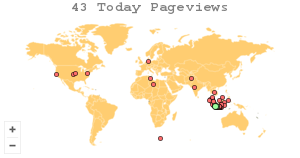DIMENSI KOMODIFIKASI MUSHAF ALQURAN
(Analisis Komodifikasi Mushaf Al-Qur’an Era Kontemporer)
DOI:
https://doi.org/10.47498/bashair.v3i2.2579Keywords:
Commodification, Mushaf, Qur’an, ContemporaryAbstract
One of the ways to maintain the authenticity of the Quran now is by printing and publishing official mushaf, which is regulated through a decree of the Minister of Religious Affairs of the Republic of Indonesia. And the phenomenon of industrialization has spread to various aspects of life, even religion. The Quran is a religious symbol that has experienced the most industrialization process through the Quran printing process. Therefore, this article aims to analyze the extent of the commodification of the Quran in Indonesia so that the Mushaf becomes a commodity. Using a qualitative method and descriptive-analytical techniques with the lens of religious commodification, this paper finds that the market for Quran copies in the contemporary era is those who are technologically literate. Thus, Quran copies are printed on a large scale and marketed in offline and online stores with the aim of meeting people's needs for the Quran. Therefore, the commodification process is based on the people's need for the Quran which is increasing from time to time, and is supported by government policies related to the printing of the Quran copies. Even though the Quran copies are printed without using attachments and additional features but purely the text of the Quran, the copies will still become commodities. Due to the increasing demand of the community for the Mushaf and becoming a business field for Mushaf printing, it results in a process of production by producers and consumption by consumers, which then results in buying and selling transactions of Quran copies. And in the end there was a dimension of commodification in the manuscripts of the Koran.
References
Abadi, M. M. (2009). ISLAM , TRADISI DAN INDUSTRIALISASI. KARSA, 16(2). https://doi.org/10.19105/karsa.v16i2.101
Akbar, A. (2011). Pencetakan Mushaf Al-Qurâan di Indonesia. SUHUF, 4(2), 271–287. https://doi.org/10.22548/shf.v4i2.57
Al-Qolam. (n.d.). Alquran Mushaf Grand Maqamat Talking Pen. https://alqolam.com/product/al-quran-mushaf-grand-maqamat-talking-pen/
Al-Qolam. (2018). Review Alquran Mushaf Maqamat For Kids. https://www.youtube.com/watch?v=AYnSYyyMmt0&t=233s
Alquran, S. (n.d.). Alquran Cordoba Amazing 101 in 1. Sentra Alquran. https://www.sentraalquran.com/tafsir-alquran/al-quran-cordoba-amazing-101-in-1/
Bruinessen, M. Van. (1995). Kitab Kuning, Pesantren dan Tarekat: Tradisi-Tradisi Islam di Indonesia,. Mizan.
Cordoba. (2012). Alquran Cordoba Amazing 101 in 1. Cordoba.
Faddad, Z., & Mardiah, A. (2020). Komodifikasi Agama dalam Gerakan Majlis Tafsir Al-Qur’an (MTA) di Surakarta. Religió: Jurnal Studi Agama-Agama, 10(1), 118–139. https://doi.org/10.15642/religio.v10i1.1311
Fais, N. L. (2021). Komodifikasi Al-Quran: Analisa Sosial terhadap Mushaf Al-Qur’an Grand Maqamat. MAGHZA: Jurnal Ilmu Al-Qur’an Dan Tafsir, 6(2), 172–188. https://doi.org/10.24090/maghza.v6i2.4848
Fakhruroji, M. (2005). Privatisasi Agama : Globalisasi dan Komodifikasi Agama. Jurnal Dakwah Dan Komunikasi, 193–211.
Firmansyah, A. (2023). Kemenag targetkan UPQ mampu cetak 2 juta Al Quran per tahun pada 2024. Antara. https://m.antaranews.com/amp/berita/3422292/kemenag-targetkan-upq-mampu-cetak-2-juta-al-quran-per-tahun-pada-2024
Hakim, A. (2017). Sejarah Panjang Mushaf Al-Quran Indonesia. Kementerian Agama Republik Indonesia. https://kemenag.go.id/nasional/sejarah-panjang-mushaf-al-quran-indonesia-zdir8f
Inge, N. (2017). Aksi Sosial Berantas Buta Aksara Alquran. Liputan 6. https://www.liputan6.com/regional/read/2995417/aksi-sosial-berantas-buta-aksara-alquran
Kitiarsa, P., & Dkk. (2008). Religious Commodification in Asia: Marketing Gods. Routledge.
Mustopa. (2020). PENCETAK MUSHAF GENERASI PERTAMA DI INDONESIA. Lajnah Pentashihan Mushaf Alquran Kementerian Agama. https://lajnah.kemenag.go.id/artikel/pencetak-mushaf-generasi-pertama-di-indonesia.html
Nasional, D. P. (2008). Kamus Bahasa Indonesia. Pusat Bahasa.
Nugraha, E. (2014a). Saat Muṣḥaf al-Qur ’ ān Menjadi Komoditas. Refleksi, 13(6), 741–760. http://repository.uinjkt.ac.id/dspace/handle/123456789/31328
Nugraha, E. (2014b). Tren Penerbitan Mushaf dalam Komodifikasi Al-Qur’an di Indonesia. Ulumuna, 18(2), 26. https://doi.org/10.20414/ujis.v18i2.859
Rohimin. (2016). Jejak dan Otoritas Pencetakan Mushaf Al-Quran di Indonesia. Nuansa, 9(2), 198. https://d1wqtxts1xzle7.cloudfront.net/63645274/jejak_dan_otoritas_pencetakan_mushaf_al-_quran_di_indonesia_615-1108-1-SM20200616-59118-1tjv4rf-libre.pdf?1592316508=&response-content-disposition=inline%3B+filename%3DJEJAK_DAN_OTORITAS_PENCETAKAN_MUSHAF_AL.
Shopee. (n.d.). Harga Mushaf Alquran Grand Maqamat. https://shopee.co.id/Mushaf-Al-Quran-GrandMaqamat-i.40214087.669856831
Starrett, G. (1995). The Political Economy of Relegious Commidities in Cairo. American Anthropologist, 97(1), 51–68. https://scholar.google.com/scholar?hl=id&as_sdt=0%2C5&q=The+Political+Economy+of+Relegious+Commodities+in+Cairo&btnG=
Syahputra, I. (2016). AGAMA DI ERA MEDIA: Kode Religius dalam Industri Televisi Indonesia. ESENSIA: Jurnal Ilmu-Ilmu Ushuluddin, 17(1), 125. https://doi.org/10.14421/esensia.v17i1.1283
Turner, B. S. (2010). The New Blackwell Companion to the Sociology of Religion. Willey-Blackwell.
Downloads
Published
Issue
Section
License
Authors who publish articles in Basha'ir: Jurnal Studi Al-Qur'an & Tafsir agree to the following conditions:
- The author retains copyright and grants the Basha'ir Journal the right from the first publication with the work simultaneously licensed under a Creative Commons Attribution-ShareAlike 4.0 International (CC BY-SA 4.0) license that allows others to make changes, adjust and build on the work with recognition of the author's work and initial publication in the Journal.
- Authors are allowed to copy and redistribute published versions of works in journals (for example, posting them to institutional repositories or publishing them in a book), with recognition of their initial publication in Basha'ir: Jurnal Studi Al-Qur'an & Tafsir.
- Authors are allowed and encouraged to post their work online (for example, in institutional repositories or on their websites) before and during the submission process, as it can lead to productive exchanges, and increase citations of published works






